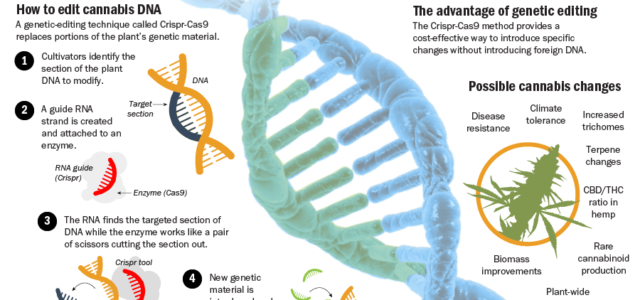Genetic editing offers hemp and marijuana companies a way to improve plant strains
CBDFeaturedIndustrial Hemp NewsMarijuana Laws, Regulations, & Politics February 24, 2021 MJ Shareholders 0

This story first appeared at Marijuana Business Daily.
The development of new genetic-editing technology offers cannabis companies a cost-effective way to make specific changes to marijuana and hemp plants – such as more disease resistance – without creating a genetically modified organism.
The technology, known as Crispr-Cas9, will allow the cannabis industry to build new, improved plants that promise to introduce hardiness and efficiencies into cultivation.
That, in turn, could boost profits.
Developed by Emmanuelle Charpentier and Jennifer A. Doudna, the Crispr-Cas9 gene-editing technique revolutionizes genetic engineering in many fields, including medicine and agriculture.
They were awarded the 2020 Nobel Prize in chemistry for their work.
In the case of cannabis, Crispr gene editing can produce new testable strains within a matter of weeks – unlike previous, more manual techniques.
Some possible changes to the cannabis genome include:
- Disease resistance: Large-scale agriculture is susceptible to various pests and diseases. The technique should provide a way to quickly create resistant plants.
- Climate tolerance: Climate change will alter how cannabis is grown in the coming decades. Plants that can withstand a wider range of temperature and daylight will be valuable as that occurs.
- Increased trichomes: Researchers are trying to increase the trichome density on the plants as a way to boost the production of terpenes and cannabinoids.
- Terpene manipulation: Changing the terpene makeup of a plant could provide a way to create distinctive and brandable cannabis products.
- CBD-to-THC ratio: Hemp producers use the gene-editing technique to inhibit or eliminate the production of THC in the plants. It can also be used to manipulate the creation of CBD.
- Biomass improvements: The ability to create specific traits and improvements to non-THC and CBD producing biomass of plants could help increase cultivator profits by minimizing plant waste.
- Plant-wide THC production: In the vein of biomass improvements, work has already begun on the development of marijuana plants that produce THC in more parts of the plant.
- Novel cannabinoid production: As the industry begins to understand cannabinoids other than THC and CBD, look for gene editing to be at the forefront of manipulating plants to produce them.
The Crispr-Cas9 process creates new DNA but technically does not create a genetically modified organism (GMO) because it does not introduce foreign DNA to the plant.
The process works by removing the section of the DNA the cultivator is hoping to change.
In addition, a guide piece of RNA is created and attached to an enzyme called Cas9.
Together, these two elements make up the Crispr tool.
The tool finds the targeted section of DNA while the enzyme cuts out the section as scissors would. New genetic material is introduced and attaches to the missing segment.
Companies are already using the technique to manipulate hemp and marijuana plants.
Evergreen, Colorado-based Ebbu, which was acquired by Canada-based Canopy Growth Corp. in 2018, was an early adopter of gene-editing techniques to try to produce single-cannabinoid strains, among other traits.
CanBreed, an Israeli company focused on developing genetically stable seeds, licensed the Crispr technology to enhance the traits of those seeds.
In late 2020, CanBreed announced the purchase of a 3.5-acre farm in San Diego.
MJ Shareholders
MJShareholders.com is the largest dedicated financial network and leading corporate communications firm serving the legal cannabis industry. Our network aims to connect public marijuana companies with these focused cannabis audiences across the US and Canada that are critical for growth: Short and long term cannabis investors Active funding sources Mainstream media Business leaders Cannabis consumers












No comments so far.
Be first to leave comment below.